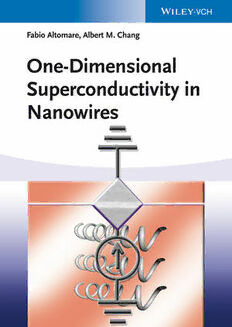
One-Dimensional Superconductivity in Nanowires PDF
Preview One-Dimensional Superconductivity in Nanowires
FabioAltomareandAlbertM.Chang One-DimensionalSuperconductivity inNanowires RelatedTitles Bezryadin,A. Wong,B.,Mittal,A.,Cao,Y.,Starr,G.W. Superconductivityin Nano-CMOS Circuit and Nanowires Physical Design FabricationandQuantumTransport 2004 2012 ISBN:978-0-471-46610-9 ISBN:978-3-527-40832-0 Buckel,W.,Kleiner,R. Bhattachariya,R.,Parantharam,M.P. Superconductivity HighTemperature FundamentalsandApplications Superconductors 2004 ISBN:978-3-527-40349-3 2010 ISBN978-3-527-40827-6 Reich,S.,Thomsen,C.,Maultzsch,J. Luryi,S.,Xu,J.,Zaslavsky,A. Carbon Nanotubes FutureTrendsin BasicConceptsandPhysicalProperties Microelectronics 2004 UptheNanoCreek ISBN:978-3-527-40386-8 2007 ISBN:978-0-470-08146-4 Wolf,E.L. Nanophysicsand Nanotechnology AnIntroductiontoModernConceptsin Nanoscience 2006 ISBN:978-3-527-40651-7 Fabio Altomare and Albert M. Chang One-Dimensional Superconductivity in Nanowires WILEY-VCH Verlag GmbH & Co. KGaA TheAuthors AllbookspublishedbyWiley-VCHarecarefully produced.Nevertheless,authors,editors,and Dr.FabioAltomare publisherdonotwarranttheinformation D-WaveSystemsInc. containedinthesebooks,includingthisbook,to 100-4401StillCreekDrive befreeoferrors.Readersareadvisedtokeepin Burnaby,BC,V5C6G9 mindthatstatements,data,illustrations, Canada proceduraldetailsorotheritemsmay inadvertentlybeinaccurate. Prof.AlbertM.Chang DukeUniversity LibraryofCongressCardNo.: DepartmentofPhysics appliedfor PhysicsBuilding ScienceDrive BritishLibraryCataloguing-in-PublicationData: Durham,NC27708-0305 Acataloguerecordforthisbookisavailable USA fromtheBritishLibrary. Bibliographicinformationpublishedbythe CoverFigure DeutscheNationalbibliothek Artisticrenderingofan8nmwide,20μmlong TheDeutscheNationalbibliothekliststhis nanowirefabricatedonanInPsemiconducting publicationintheDeutscheNationalbibliografie; stencil.Electricalcontactstothenanowire(left detailedbibliographicdataareavailableonthe andrightpads)arerealizedduringthenanowire Internetathttp://dnb.d-nb.de. deposition.Atthecenter,aQPSjunctionis currentbiasedbyacurrentsource:Thenumber ©2013WILEY-VCHVerlagGmbH&Co.KGaA, ofwindingsofthephaseoftheorderparameter Boschstr.12,69469Weinheim,Germany decreasesbecauseofaphaseslippageevent.The diagramdoesnotindicatetheactualnanowire Allrightsreserved(includingthoseoftranslation connectioninacircuit.Renderingofthe intootherlanguages).Nopartofthisbookmay windingscourtesyofA.DelMaestro. bereproducedinanyform–byphotoprinting, microfilm,oranyothermeans–nortransmitted ortranslatedintoamachinelanguagewithout writtenpermissionfromthepublishers.Regis- terednames,trademarks,etc.usedinthisbook, evenwhennotspecificallymarkedassuch,are nottobeconsideredunprotectedbylaw. Composition le-texpublishingservicesGmbH, Leipzig PrintingandBinding betz-druckGmbH, Darmstadt CoverDesign Adam-Design,Weinheim PrintISBN 978-3-527-40995-2 ePDFISBN 978-3-527-64907-5 ePubISBN 978-3-527-64906-8 mobiISBN 978-3-527-64905-1 oBookISBN 978-3-527-64904-4 PrintedintheFederalRepublicofGermany Printedonacid-freepaper V ToMariaElena,Mattia,Gabriele,Giuliaandtomyparents: Thankyouforyourloveandsupport. Fabio Tomyfamily:Ying,EmilyandAustin,mysisterMargaret,mybrotherWinston, myfatherBertrandTsu-Shen,andmylatemother,VirginiaPang-Ying. Albert VII Contents Preface XI AbbreviationsandSymbols XV ColorPlates XXI PartOne TheoreticalAspectsofSuperconductivityin1DNanowires 1 1 Superconductivity:BasicsandFormulation 3 1.1 Introduction 3 1.2 BCSTheory 4 1.3 Bogoliubov–deGennesEquations–QuasiparticleExcitations 8 1.4 Ginzburg–LandauTheory 10 1.4.1 Time-DependentGinzburg–LandauTheory 12 1.5 GorkovGreen’sFunctions,Eilenberger–Larkin–OvchinnikovEquations, andtheUsadelEquation 12 1.6 PathIntegralFormulation 19 References 27 2 1DSuperconductivity:BasicNotions 31 2.1 Introduction 31 2.2 ShapeResonances–OscillationsinSuperconductivityProperties 33 2.2.1 EarlyTreatmentsofShapeResonancesin2DFilms 35 2.2.2 Bogoliubov–deGennesEquations,FiniteTemperature,andParabolic- BandApproximationforRealisticMaterials 40 2.2.3 NumericalSolutionsandThinFilmShapeResonances 42 2.2.4 1DNanowires–ShapeResonancesandSizeOscillations 45 2.3 SuperconductivityinCarbonNanotubes–Single-WalledBundlesand IndividualMultiwalledNanotubes 48 2.4 PhaseSlips 50 2.4.1 FiniteVoltageinaSuperconductingWireandPhaseSlip 51 2.4.2 PhaseSlipinaJosephsonJunction 52 2.4.3 Langer–Ambegaokar Free EnergyMinimain theGinzburg–Landau Approximation 55 2.4.4 TransitionRateandFreeEnergyBarrier 59 VIII Contents 2.4.5 FreeEnergyBarrierforaPhaseSlipintheGinzburg–LandauTheory 60 2.4.6 PhysicalScenarioofaThermally-ActivatedPhaseSlip 64 2.4.7 McCumber–HalperinEstimateoftheAttemptFrequency 66 References 71 3 QuantumPhaseSlipsandQuantumPhaseTransitions 75 3.1 Introduction 75 3.2 Zaikin–GolubevTheory 79 3.2.1 DerivationoftheLowEnergyEffectiveAction 80 3.2.2 CoreContributiontotheQPSAction 88 3.2.3 HydrodynamicContributiontothePhase-SlipAction 91 3.2.4 QuantumPhase-SlipRate 92 3.2.5 QuantumPhase-SlipInteractionandQuantum-PhaseTransitions 95 3.2.6 WireResistanceandNonlinearVoltage–CurrentRelations 97 3.3 Short-WireSuperconductor–InsulatorTransition:Büchler,Geshkenbein andBlatterTheory 100 3.4 Refael,Demler,Oreg,FisherTheory–1DJosephsonJunctionChains andNanowires 105 3.4.1 DiscreteModelof1DJosephsonJunctionChains 107 3.4.2 ResistanceoftheJosephsonJunctionsandtheNanowire 114 3.4.3 MeanFieldTheoryoftheShort-WireSIT 116 3.5 Khlebnikov–PryadkoTheory–MomentumConservation 121 3.5.1 Gross–PitaevskiiModelandQuantumPhaseSlips 123 3.5.2 Disorder Averaging,QuantumPhaseTransitionandScalingforthe ResistanceandCurrent–VoltageRelations 126 3.5.3 ShortWires–LinearQPSInteractionandExponentialQPSRate 130 3.6 QuantumCriticalityandPair-Breaking–UniversalConductanceand ThermalTransportinShortWires 136 References 143 4 Duality 149 4.1 Introduction 149 4.2 Mooij–NazarovTheoryofDuality–QPSJunctions 152 4.2.1 QPS Junction Voltage-Charge Relationship and Shapiro Current Steps 156 4.2.2 QPSQubits 157 4.3 KhlebnikovTheoryofInteractingPhaseSlipsinShortWires:Quark ConfinementPhysics 159 References 165 5 ProximityRelatedPhenomena 167 5.1 Introduction 167 5.2 Transport Propertiesof Normal-SuperconductingNanowire-Normal (N-SCNW-N)Junctions 169 5.2.1 NonequilibriumUsadelEquations 169 5.2.2 ParameterizationoftheUsadelEquations 174 Contents IX 5.2.3 NumericalResults 175 5.3 Superconductor–Semiconductor Nanowire–Superconductor Junctions 179 5.4 Majorana Fermion in S-SmNW-S Systems with Strong Spin–Orbit InteractionintheSemiconductor 184 References 188 PartTwo ReviewofExperimentson1DSuperconductivity 193 6 ExperimentalTechniqueforNanowireFabrication 195 6.1 Experimental Technique for the Fabrication of Ultra Narrow Nanowires 195 6.2 IntroductiontotheTechniques 196 6.2.1 Lithography 197 6.2.2 MetalDeposition 198 6.2.3 Etching 199 6.2.4 PuttingItAllTogether 199 6.3 Step-EdgeLithographicTechnique 201 6.4 MolecularTemplating 202 6.5 SemiconductingStencils 205 6.6 NatelsonandWillet 205 6.7 SNAPTechnique 206 6.8 ChangandAltomare 208 6.9 TemplateSynthesis 209 6.10 OtherMethods 211 6.10.1 IonBeamPolishing 211 6.10.2 AngledEvaporation 213 6.10.3 ResistDevelopment 213 6.11 FutureDevelopments 214 References 216 7 Experimental Review of Experiments on 1D Superconducting Nanowires 219 7.1 Introduction 219 7.2 Filtering 220 7.3 PhaseSlips 221 7.4 OverviewoftheExperimentalResults 223 7.4.1 Giordano’sExperiments 225 7.4.2 RecentExperimentsonQPS 226 7.4.3 QPSProbedviaSwitchingCurrentMeasurements 239 7.5 OtherEffectsin1DSuperconductingNanowires 248 7.5.1 S-ShapedCurrent–VoltageCharacteristic 248 7.6 AntiproximityEffect 250 7.6.1 StabilizationofSuperconductivitybyaMagneticField 253 7.6.2 ShapeResonanceEffects 255 References 257 X Contents 8 CoherentQuantumPhaseSlips 263 8.1 Introduction 263 8.2 ASingle-ChargeTransistor Based ontheCharge-Phase Dualityofa SuperconductingNanowireCircuit 263 8.3 QuantumPhase-SlipPhenomenoninUltranarrowSuperconducting Nanorings 266 8.4 CoherentQuantumPhaseSlip 267 8.5 Conclusion 272 References 273 9 1DSuperconductivityinaRelatedSystem 275 9.1 Introduction 275 9.2 CarbonNanotubes 275 9.2.1 ProximityEffectsinSWNT 276 9.2.2 IntrinsicSuperconductivityinSWNT 278 9.2.3 SuperconductivityinRopesMediatedbytheEnvironment 281 9.3 MajoranaExperiments 286 9.3.1 MajoranaExperimentinSemiconductingNanowires 286 9.3.2 MajoranaExperimentinHybridSuperconductor-TopologicalInsulator Devices 290 9.4 SuperconductingNanowiresasSingle-PhotonDetectors 292 References 297 10 ConcludingRemarks 301 Index 303 XI Preface Thisbookisdevotedtothetopicofsuperconductivityinverynarrowmetallicwires. Interestinsuchwiresisdrivenbythecontinuingdriveforminiaturizationinthe electronicsindustry,wherethereductionofheatdissipationbytheuseofintercon- nectswhicharesuperconductingmaybenecessary.Thishasledtotheinvention ofnewmethodsofproducingverynarrowwireswithgoodqualityanduniformity indimensions,andopenedupthepossibilityofnoveldeviceparadigms. Thesuperconductingstateisastateofcoherentpairsofelectrons,heldtogether bythemechanismoftheCooperinstability.Whenthelateraldimensionsaresmall, anewpathwayopensupforthesuperconductortoproducedissipation,associated withtheenhancedrateatwhichfluctuationscanoccurinthecomplexorderparam- eter – a quantity which describes the magnitude and phase of the Cooper pairs. In many regimes, the fluctuations of the phase of the Cooper pairs is often the dominantprocess,inanalogywithwhatoccursindissipativeJosephsonjunctions. Thisnewpathwayisrelatedwiththemotionofvorticesintype-IIsuperconductors, whichgivesrisetodissipationin2D(two-dimensional)andbulksuperconductors, inwhicharapidchangeofphaseoccursasavortexpassesby.Here,becauseofthe physicaldimensionofthesystem(comparableto10nm),thevortexquicklypasses acrosstheentirenarrowwire,producingdissipationintheprocess. Althoughnanowiresaresmallintheirtransversedimensions,theyarestillmuch largerthantheFermiwavelength(λ )oftheelectronicsystem,whichisoftheorder F ofafewangstrominallmetals.InconventionalsuperconductorssuchasAl,Pb, Sn,Nb,MoGe,andsoon,inthinfilmornanowireform,thecoherencelengthis (cid:3) (cid:2)5(cid:3)100nm,typically10–1000timestheFermiwavelength.Thesystemwewill consideristhereforeinasortofmixed-dimensionalregime.Fromthecondensate perspective,thesystemis1D(one-dimensional),inthesensethatthetransversedi- mensionsaresmallerthantheCooperpairsize:forthisreason,thewavefunction, oralternatively,theorderparameter,describingtheCooperpairs,isuniform,and thusposition-independent,inthetransversedirections.Fromthefermionicquasi- particleexcitationperspective,thesystemiseffectively3D(three-dimensional; λ F ismuchsmallerthanthelateraldimension)andthereisalargenumberoftrans- verse channels(from(cid:2) 100 in a multiwalledcarbon nanotube, to (cid:2) 3000 in an (cid:2) 8nmdiameteraluminumnanowire),analogoustotransversemodesinawave guide.
